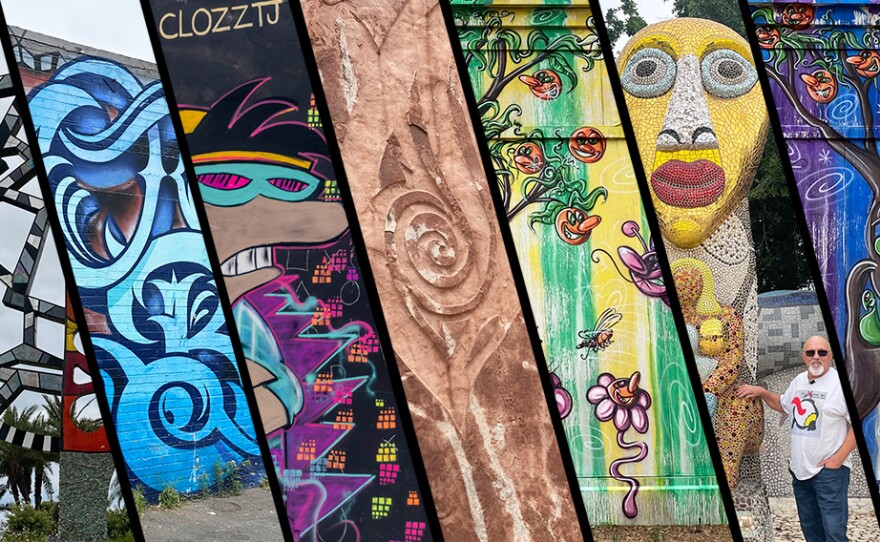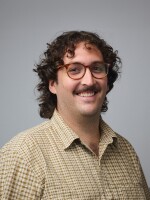Just steps away from a swing set, slide and jungle gym, with the laughter of children and the sound of crashing waves in the background, you'll find a playground made out of concrete and tile.
"The Map," as it’s affectionately called, is a 2,500-square-foot mosaic completed in 2020. This massive piece of public art sits at the Walter Munk Educational Plaza at La Jolla Shores in Kellogg Park.
It depicts the Grand Canyons of La Jolla as well as more than 100 different species of animals indigenous to California’s coast — using hundreds of thousands of pieces of hand-cut tile, glass, and even fossils.

Making a mosaic of this size is not easy, and it’s only possible thanks to a technique called LithoMosaic. It was invented by two of the artists, Robin Brailsford and Wick Alexander, along with concrete specialists.
The patented process is a remix of the classic mosaic technique of securing tile to a surface with mortar and grout. Instead, LithoMosaic uses monolithic concrete pours.
Brailsford said part of the reason she came up with the process was to accommodate her big ideas.
"Well, I tend to be a person who thinks big," she said. "And this is a technique that really only works for big."
Another reason was the environmental limitations of traditional mosaics. Brailsford explained how in colder climates, the water in the grout would expand as it froze, causing the tiles to pop out.
"So LithoMosaic did two things," she said. "It allows us to work super large, one just went in this week in Tempe, Arizona that’s 750 square feet. And it also has figured out a way through the chemical balance of the concrete and with the techniques that we put into it to allow it to go in in a freestyle environments. So we have it in Alaska and Nevada, New Mexico places where you wouldn't normally be able to have mosaics."

Making the mosaic
Brailsford and Alexander created The Map with artists Kelsy Hartley and Mariah Armstrong Conners for the Walter Munk Foundation for the Oceans in collaboration with the Scripps Institution of Oceanography. The Map, as well as Brailsford's other public works, all begin with extensive research of the site and subject matter.
"When I have a project or when I have identified a site that I want to do for my own without a public art commission, I study it really hard," she said. "I am there. I watch the sunrise, the moon set, whatever. I talk to the people. I research a lot in the libraries. I read a lot of books. All my project proposals have extensive bibliographies for the research I've done."
A lot of that reading happens at Brailsford and Alexander's home studio nestled in the hills of East San Diego County, where the shelves are overflowing with books.
"We're at a funny point now where the house doesn't have very many walls and all the walls it can have either paintings or bookshelves," Brailsford said laughing. "So, you know how many more books do we buy is the current problem?"
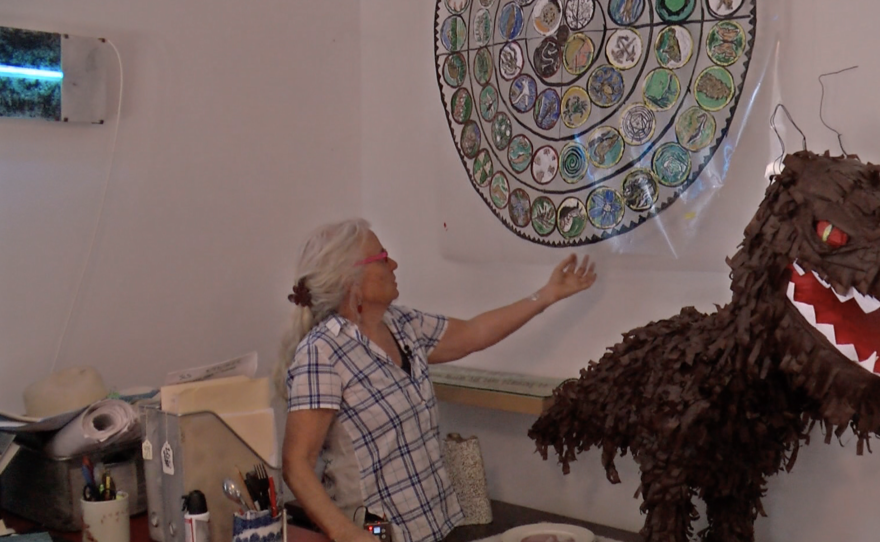
Once the research is done, the next step is design conception.
"I do all my LithoMosaic layouts. I paint them on clear plastic. Because I'm basically a glass artist and so most comfortable working in glass. That's why you know things that you're seeing that are older are glass. So anyway, I paint on both sides of a piece of clear plastic like this. And I can really get the effect that I want. And what the LithoMosaics are gonna be like," Braislford said.
Then, the labor-intensive work of hand-cutting and placing each piece of tile begins. In the LithoMosaic process, tiles are secured upside down to mesh with water based glue. After the layout is complete, it’s time to install the mosaic. This is done by concrete professionals.
"So they take it and they lay it upside down and the monolithic concrete pour. Pull off the plastic. And then they trowel it, trowel it, trowel it, and then when the concrete has begun to settle a little bit, enough to hold the tiles in place, then they peel the mesh back and the tiles are actually there in place and no mesh and no grouting and no buckets and no back-breaking work on our part," Brailsford explained.

Shaw & Sons Concrete Contractors out of Costa Mesa, Calif. installed The Map. Brailsford described the process like a dance.
“Imagine putting this much tile in your kitchen," she said. "So what they were doing was on one end, they were troweling this one in and over here, they had the pumper truck and they were up to their ankles, you know, pumping in the concrete and leveling it and then bringing over the next one at the same time. And it's the ballet of the highest order of how they put it together."
Diving deeper
If you visit The Map, the first thing you notice is the sheer size of the mosaic. But as you begin to take it all in, the tiny details are what really grab your attention, especially when you think about how each tile was hand cut and placed exactly in that particular spot, for a very specific reason.
There are two main layers to the mosaic: The different animals and the map of the canyons.
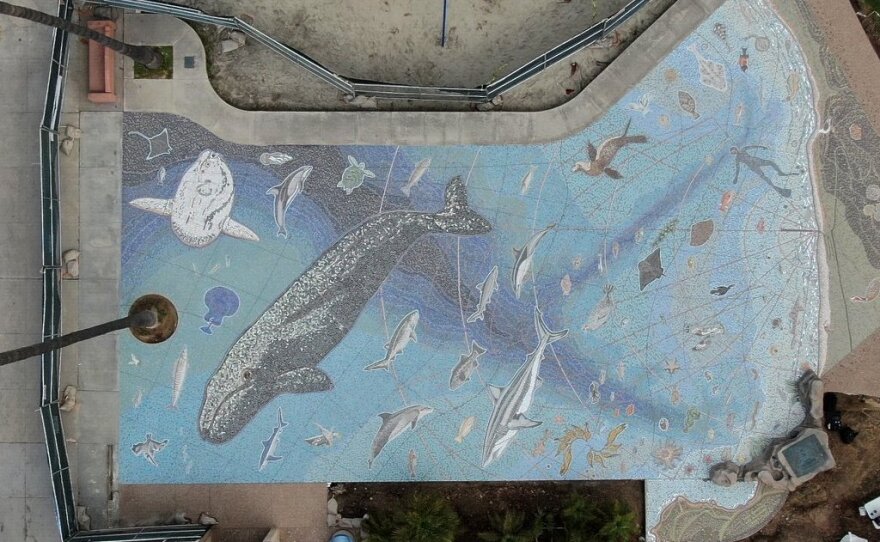
Mariah Armstrong Conners was responsible for designing the map portion, and while it's hard to tell from the ground, a birds-eye view will show how the different color gradients of tile create a depth effect, fading to darker as the canyons deepen.
"Just figuring out the color transitions with the tiles we had took a lot of thought," Armstrong Conners said.
The animals were divvied up among the team, so each species — if you look close enough — has a distinct style. For example, the skates and rays, some of which were designed by Brailsford, use what she calls a "rebel angle," or patterns that are a bit chaotic and unconventional in their design.
"Where there are skates and rays that just look like the sand on the bottom (of the ocean), we ended up making them be patterns or something the real ray might not necessarily have, but it worked really well in the mosaic," Brailsford said.
The sharks and some of the fish were designed by Alexander. They are more linear and sharp in their design. And the birds that appear on The Map are by Kelsy Hartley.
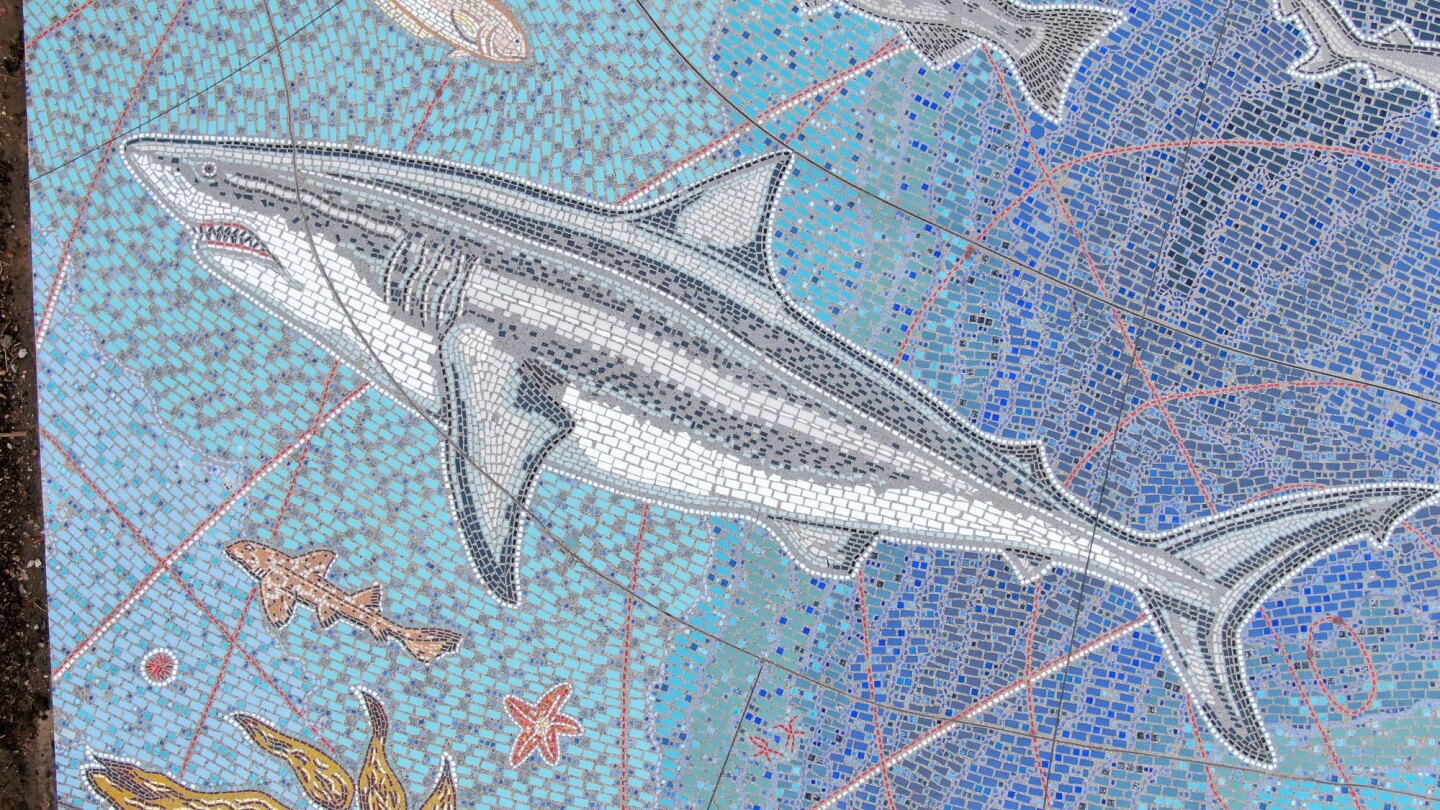

An educational mission
The Walter Munk Foundation for the Oceans worked with the city and community stakeholders to bring the mosaic to life.

Walter Munk is widely considered to be the father of modern oceanography. He was one of the first scientists to bring statistical methods to the analysis of oceanographic data.
He died in 2019 before The Map was finished. But the mosaic continues his legacy of teaching the next generation about the oceans and the animals that call it home, because first and foremost, The Map is an incredibly unique educational tool. According to Munk's wife Mary Munk, The Map is visited by 3 to 4 million people a year, many of them students on school field trips.
"Our oceans, and the species that call it home are in big trouble," Mary Munk said. "We hope that this format can help people become better stewards."
And the beauty of public art is that it’s for everyone, Brailsford said.
"Well, I was just talking about one of my collaborators, Kelsey Hartley on the phone, and she was pointing out that in this time right now, mortgages are expensive, COVID has left people without jobs," she said. "There's a lot of uncertainty in the world. And what's great about public art and something like this is you can really interact and own it. I love the fact that my things don't belong to anybody and they belong to everybody and you can be here at midnight, you can be here at three o’clock in the morning, you can be homeless, you can have the biggest house in La Jolla and you all get to experience it at the same in the same way."
From a 31-foot juvenile gray whale to a life-size great white shark, this mosaic offers the public a chance to explore the ocean's wonders without having to get wet.


